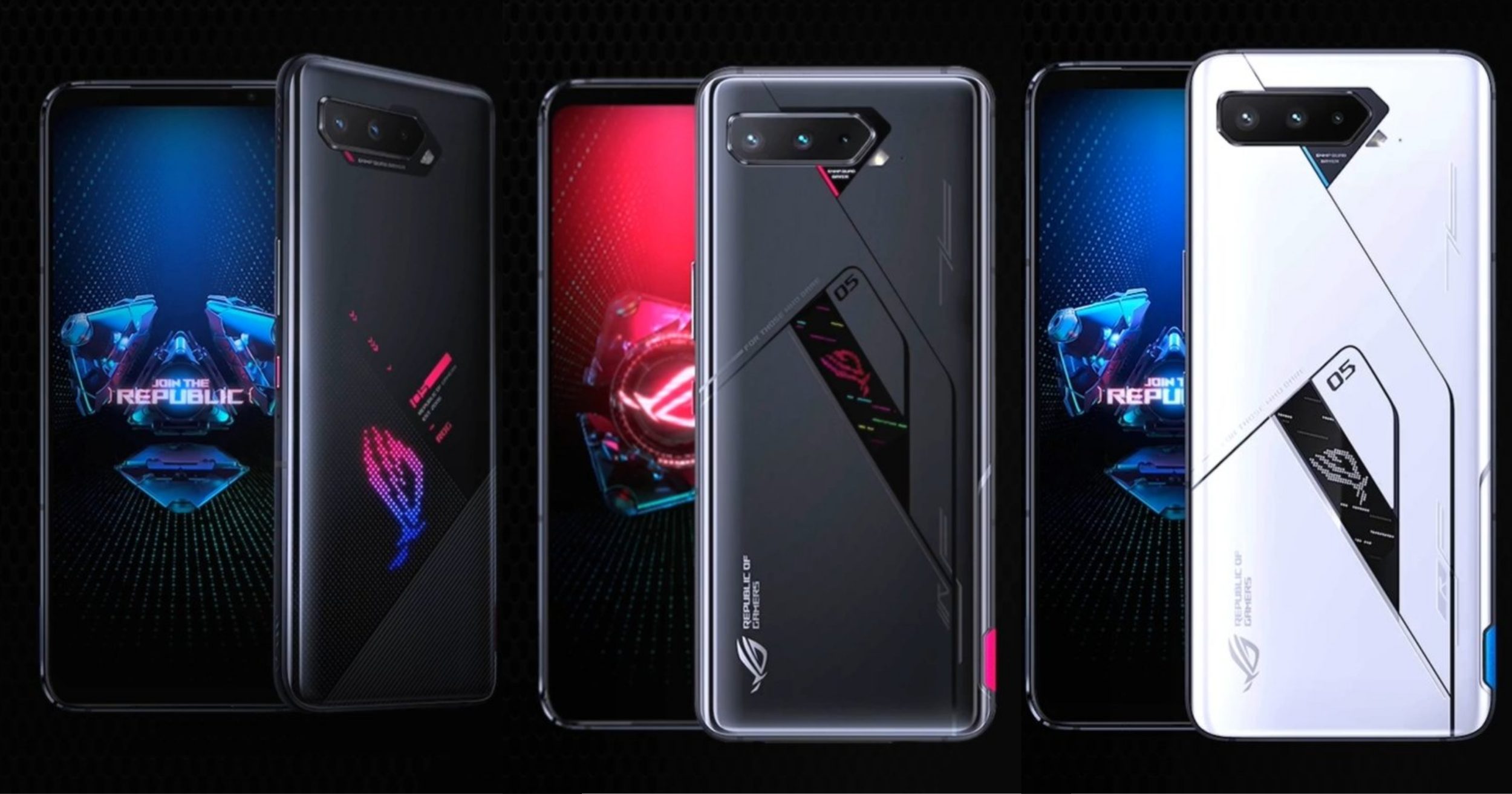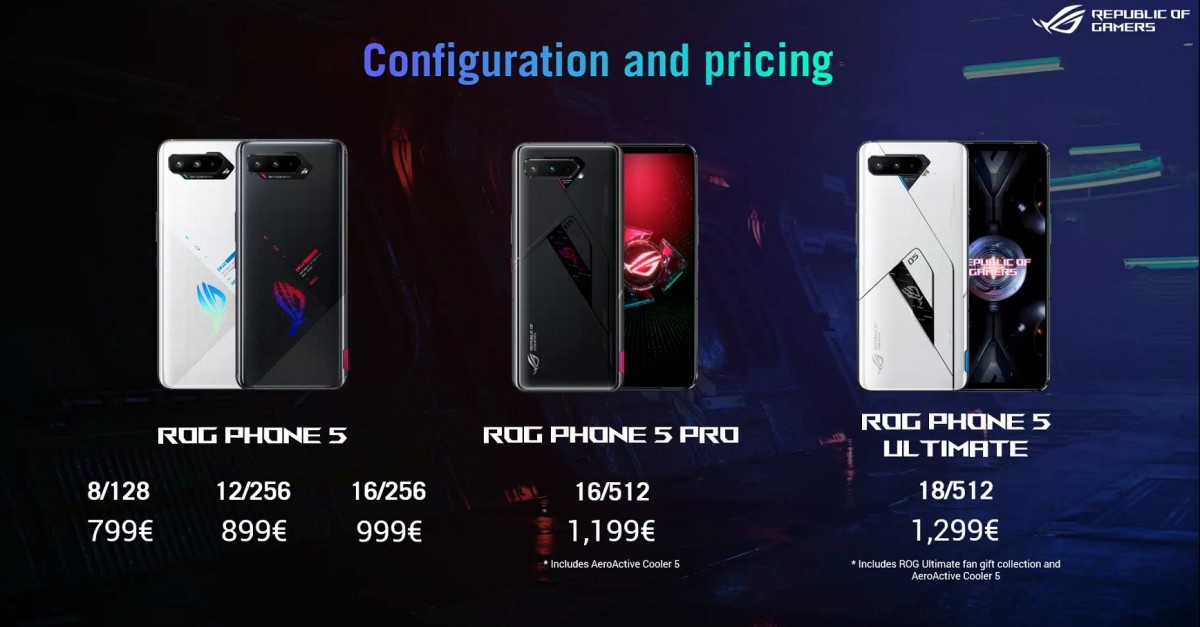❤ ASUS Rog Phone 5
Another year, another ROG Phone. Asus has relentlessly been keeping up its efforts to deliver “The ultimate smartphone gaming experience” for four years now. With great success, we might we add.
This time around, we have the shiny new ROG Phone 5 to get acquainted with. A Republic of Gamers product through and through, but one that does things a bit differently than its predecessors in some regards, while staying true to form in many others. There’s plenty to discuss, so without further ado, we’ll just jump straight into it.
First things first. Yes, it’s the ROG Phone 5 instead of 4. Don’t worry about it; you haven’t accidentally skipped an iteration along the way. The explanation is actually simple and one that we have encountered before with Chinese and Taiwanese naming conventions. The number ‘four’ in Chinese just happens to sound similar to their word for death, so naming products after this number is considered unlucky and is avoided.
That’s ironically, probably the least intriguing bit about the ROG Phone 5, though. Let’s start with the fact that the ROG Phone 5 is more of a family of devices than a single model.
Asus ROG Phone 5 specs at a glance:
- Body: 172.8×77.3×10.3mm, 238g; metal body; RGB light panel (on the back), Pressure sensitive zones (Gaming triggers).
- Display: 6.78″ AMOLED, 1B colors, 144Hz, HDR10+, 800 nits (typ), 1200 nits (peak), 1080x2448px resolution, 20.4:9 aspect ratio, 395ppi.
- Chipset: Qualcomm SM8350 Snapdragon 888 (5 nm): Octa-core (1×2.84 GHz Kryo 680 & 3×2.42 GHz Kryo 680 & 4×1.80 GHz Kryo 680); Adreno 660.
- Memory: 128GB 8GB RAM, 256GB 12GB RAM, 256GB 16GB RAM; UFS 3.1.
- OS/Software: Android 11, ROG UI.
- Rear camera: Wide (main): 64 MP, f/1.8, 26mm, 1/1.73″, 0.8µm, PDAF; Ultra wide angle: 13 MP, f/2.4, 11mm, 125˚; Macro: 5 MP, f/2.0.
- Front camera: 24 MP, f/2.5, 27mm (wide), 0.9µm.
- Video capture: Rear camera: 8K@30fps, 4K@30/60/120fps, 1080p@30/60/120/240fps, 720p@480fps; gyro-EIS; Front camera: 1080p@30fps.
- Battery: 6000mAh; Fast charging 65W, Reverse charging 10W, Power Delivery 3.0, Quick Charge 5.
- Misc: Fingerprint reader (under display, optical); NFC; 3.5mm jack.
There are anywhere between two to five distinct versions available, depending on how you count them. The vanilla ROG Phone 5 has an A, B and C variant, denoting their differences in available bands and network connectivity, as well as memory variants. Starting from variant “C”, the base configuration is an 8GB/128GB one with a 12GB/256GB tier also available. Variant “B” adds a third option to the list – 16GB/256GB. Variant “A” is not available in the base 8GB/128GB tier, but can be had in both 12GB/256GB and 16GB/256GB configs.
Granted, clearly, some of these variants are meant for different markets. Still, that’s already plenty confusing in our mind, but things extend past the vanilla ROG Phone 5 this year. And we’re not talking about a “Strix” variant, like in previous generations, which might still be a thing. Instead, this year Asus has an ROG Phone 5 Pro, as well as and ROG Phone 5 Ultimate.
The Pro variant has 16GB of RAM and 512GB of storage, while Ultimate ups the RAM to a whopping 18GB of capacity. The Ultimate edition is expected to be an extremely limited offering.
There are some physical differences compared to the Pro/Ultimate. Both of these have PMOLED ROG Vision displays on the back, instead of the ROG RGB logo, as well as a pair of extra touch inputs. There are some exclusive colors and finishes – Glossy Black on the Pro and Matte While, with a satin matte finish on the Ultimate. You also need to buy either the Pro or the Ultimate to get the Asus Aeroactive Cooler 5 snap-on active cooling accessory in the box. And if you go Ultimate, you will also get an exclusive gift bag of ROG “swag” beyond that.
This particular review and all of the testing and benchmarking was done on a regular ROG Phone 5 unit with 16GB of RAM and 256GB of storage.
This variant situation is undoubtedly a bit confusing. Still, there are different ways of looking at it from a more positive angle, namely that of extra choice for the end-user and Asus trying to cast a wider net this time around in hopes of appealing to as many prospective buyers as possible.
On the flip side of this argument, there are definitely some questionable decisions with the ROG Phone 5 as well, that could be passed-off as simplification or diversification measures, but are actually kind of downgrades or “side-grades” at best. Notable examples include the rather odd fact that after two consecutive years of deliberately preserving the same footprint with ROG Phones and compatibility with the growing ROG accessory ecosystem, the chain is officially broken with the ROG Phone 5. It is slightly taller than its predecessors and leaves behind support for such killer gadgets as the Desktop Dock and the TwinView Dock.
Also, the Aeroactive Cooler is not bundled with every unit for the first time ever. And in a more general sense, while still clearly on top of its game, the ROG Phone 5 is arguably a bit “lighter” in the innovation department compared to its predecessors.
We’ll definitely dig more into these “interesting choices” surrounding the ROG Phone 5 in the following pages.
Unboxing
A great place to start seems to be the retail box itself and its contents. Getting a new ROG Phone package has always been a bit of an experience in itself. Doubly so for us, since Asus used to send actual briefcases chuck-full of accessories our way. With last year’s ROG Phone 3, the packaging started getting a bit tamer, sort of synergistically so with the design of the phone itself, which was justifiable and rather sensible.
The ROG Phone 5 takes things to the next level in more ways than one. The box we got was just a regular rectangle. A fancy one, for sure, complete with some art, but it only took us a split second to open the magnetic flap and get to the unit. No alien tetrahedranes, pyramids sliding into each other, hidden compartments, and magic augmented reality symbols. Joking aside, we appreciate the extra sensibility in an otherwise costly package that will ultimately end up in a closet somewhere.
We are a lot less appreciative of the omission of the ROG Aeroactive Cooler 5, though. Every other ROG Phone in the past used to have its corresponding Aeroactive cooler bundled. You can definitely choose whether to see this as a convenient way to save less-demanding users some money or an otherwise manufacturer-beneficial cost-saving measure. It’s up to you. Plus, you do still get one if you go for the Pro or Ultimate variant of the ROG Phone 5. Probably the former, since the latter will be extremely limited in availability.
We didn’t get any spare plastic plugs for the ROG Side connector this time around, which is not a major deal, but is still worth mentioning. On the plus side, Asus still throws in its highly-specific Aero case in black or white, to match your unit’s color. It has a particular shape mostly mandated by the need to be compatible with the Aeroactive Cooler 5, to allow for the ROG logo to be visible, while still providing at least some protection. At least the corners are covered.
For charging you still get a very versatile HyperCharger unit from Asus. It is a 65W brick that uses Asus HyperCharge technology, based on Power Delivery 3.0 + PPS at 3.3V to 21V and 3A of current. This means that you only need a decent USB 2.0 or 3.0 Type-C to Type-C cable rated at the base 3A to take full advantage of the charger. Asus provides a nice braided one in the box.
The ROG Phone 5 actually has two separate 3,000 mAh cells, with MMT tech and double-wired split design, which works in conjunction with the HyperCharge tech to allow the 65W charging speed – a clear upgrade over the ROG Phone 3, while also generating less heat. More on that later.
One interesting side note is that the 65W charger also supports Quick Charge 5.0, making it surprisingly versatile to just have on hand for all sorts of charging needs. Plus, it’s compact, especially for a non-GaN unit.
Alternatives
Even if you don’t appreciate certain aspects of devices Asus brings into the smartphone realm, there is no denying that the Taiwanese giant basically spearheaded the modern gaming smartphone niche with the ROG Phone line. It was a major gamble, a bold move and the space is still marked by plenty of uncertainty and soul-searching. That’s the beauty of big bold steps, though, that they spark innovation, and, today, four years later, Asus is not alone in the gaming smartphone space.
Sure, releases are still sporadic and experimental, more than anything else, but there is competition to point out. ZTE-owned Nubia instantly comes to mind, especially with the very recent announcement of the nubia Red Magic 6 and 6 Pro. Just like the ROG Phone 5, these are based on the flagship Snapdragon 888 chipset and even feature active fan cooling. Only theirs is an actual part of the internal design of the phones, as opposed to a snap-on accessory. Another spotlight feature of the Red Magic 6 pair, in particular, is the 165Hz refresh rate and 400Hz touch sampling rate on their 6.8-inch AMOLED displays. Both industry-leading figures, though we are not exactly sure how actual input chain latency sizes-up against Asus‘ bold claims of delivering the lowest input times in the industry with the ROG Phone 5.
ZTE nubia Red Magic 6 Pro • Xiaomi Black Shark 3S • Lenovo Legion Duel
Xiaomi has its Black Shark line, which unfortunately hasn’t been updated since the Black Shark 3S, back in August last year. With a regular Snapdragon 865 (non-plus) under the hood, it’s no longer going to be a benchmark chart-topper. Still, a potent device styled in proper gaming attire. You might want to wait a bit for the upcoming Black Shark 4 family, though.
No gaming smartphone list would be complete without Lenovo’s relatively recent entry into the scene with the Legion line. The last refresh there is the Legion Duel – a solid hardware proposition all-around, with its 144Hz AMOLED display and Snapdragon 865+ chipset. Not unlike Xiaomi, though, a new Legion, allegedly called the Legion 2 Pro is right around the corner and if rumors are to be believed, will have some sort of dual turbo cooling system to boot.
If you are not particularly partial to the gamer aesthetic or don’t really think your gaming performance would benefit all that much from any specific game optimizations, features and tweaks on a hardware or software level, there are plenty of excellent “ordinary” flagship devices to consider and still get excellent flagship performance. Vivo, for one, has you covered with the iQOO 7, which still holds the AnTuTu score record. And just a few points behind – the vivo X60 Pro+. Both are based on the Snapdragon 888 and with fast 120Hz OLED displays. The latter shining a bit brighter in the camera department.
vivo iQOO 7 • vivo X60 Pro+ • Xiaomi Redmi K40 Pro • Samsung Galaxy S21 Ultra 5G
Coincidentally, or rather not so much, we also find the excellent and very popular Xiaomi Redmi K40 Pro also on the same AnTuTu list. To be clear, we are not advising anyone to choose a device simply based on one peak performance score number. However, it is a convenient data point to consider when looking for the best performance around. Plus, with its 120Hz AMOLED panel, the K40 Pro is more than just raw muscle and has the requirements to deliver an excellent gaming experience, as well.
Speaking of an excellent gaming experience, as part of an equally-good overall phone one, why not consider one of Samsung’s Galaxy S21 phones? Ideally, one with the Snapdragon 888, instead of the Exynos 2100, in the particular context of sustained performance and thermal-throttling, which you can read more about in our in-depth comparative exploration of the two chips. Beyond that, it is worth noting that Samsung has a surprisingly competent and in-depth Game Launcher, complete with graphics and resolution tweaks, among other things.
The verdict
Nobody does smartphone gaming quite like Asus. Four iterations into the ROG Phone line, that remains a fact. The ROG Phone 5 is a true powerhouse in every sense of the word – a phone that is specifically crafted to deliver the best possible gaming experience, with any other concern or consideration taking a back seat. It just so happens that when you make an excellent gaming flagship, you usually end up with an excellent all-around device in general that has plenty of appeal outside gaming.
That has generally been our conclusion for every ROG Phone in the past, and we stand by it for the ROG Phone 5, as well. However, the ROG Phone 5 is probably the least impressive new generation we’ve seen in the ROG family.
On a hardware level, it constitutes a small upgrade over the ROG Phone 3. There are no new major spotlight features, no pushing the envelope in terms of display tech or additional controls and inputs. It’s more a case of Asus refining most aspects of the ROG Phone 3 further, but also, unfortunately, changing some odd things around. We can’t say we particularly like the new design for the side connector. It is hard to operate and fragile. Plus, it breaks compatibility with the excellent Mobile Desktop Dock. The simpler design for the AeroActive Cooler 5 also has its issues, and for the first time ever, it is not included with every unit.
Then there is the slightly taller body, likely related to the return of the 3.5mm audio jack and the newly-symmetrical exquisite speaker system, which we very-much appreciate, as well as the new split battery design, which is more of a polarizing topic, looking at the battery numbers. We don’t really mind the growth spurt, as such, but wish that it didn’t come at the expense of even more lost compatibility with the excellent ROG Phone accessory ecosystem, like the TwinView Dock.
Perhaps Asus is amidst some business “reorientation” here. Shifting focus away from end users and extravagant accessories to capture headlines and laser-focusing on delivering pro tools for the e-sports contestants and organizers exclusively. It seems to be too early to tell. Overall, we feel like the ROG Phone 5 is a truly excellent phone, still on a level of its own when it comes to mobile gaming profess, but one unfortunately experiencing some “changes” this year that managed to rub us the wrong way.
Pros
- Even more toned-down, but still ROG-inspired gamer’s design with great build quality.
- AirTigger 5 ultrasonic touch sensors are very precise and versatile. Motion controls are extended and greatly improved from last gen
- Industry-leading stereo speaker performance, complete with gaming-specific sound tweaks
- Superb AMOLED screen, 144Hz refresh rate.
- Great battery life, even at full 144Hz. Rich battery health prolonging options. Very fast charging (65W charger bundled).
- Fastest-available Snapdragon 888 chipset with an amazing thermal management.
- Great Android implementation, an unparalleled number of game tweaks, control-mapping and performance options
- Solid daylight photos, as well as low-light images. Impressive selfie quality
- Very good video quality, impressive EIS
Cons
- No longer backwards compatible with most ROG Phone II or 3 accessories. Available accessory ecosystem is significantly smaller than on previous models
- AeroActive Cooler 5 not included with the vanilla model. The new design for both the cooler and its connector are hard to align and prone to damage
- No water or dust resistance
- No microSD
- Rather basic camera setup, compared to typical 2021 flagships

















